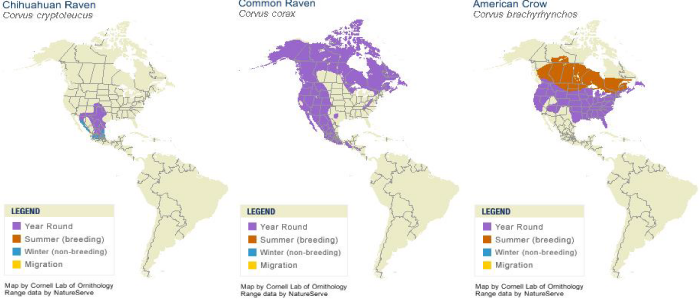
 Three big, black birds share the skies of the southwest: the Common Raven (wingspan 46 inches), the Chihuahuan Raven (wingspan 43 inches), and the American Crow (wingspan 39 inches).
Three big, black birds share the skies of the southwest: the Common Raven (wingspan 46 inches), the Chihuahuan Raven (wingspan 43 inches), and the American Crow (wingspan 39 inches).
They also share other characteristics. All are completely black; all are omnivores; all are smart and adaptable.
The Cornell Lab of Ornithology describes each as follows:
The Chihuahuan Raven: “A big black bird of the southwestern deserts, the Chihuahuan Raven is intermediate between crows and ravens in many ways. It has the shape of a raven but is the size of a crow.” The Chihuahuan Raven is featured in the free-flight program at the Arizona-Sonora Desert Museum.
The Common Raven: “Not just large but massive, with a thick neck, shaggy throat feathers, and a Bowie knife of a beak. In flight, ravens have long, wedge-shaped tails. They’re more slender than crows, with longer, narrower wings, and longer, thinner ‘fingers’ at the wingtips.”
The American Crow: “A large, long-legged, thick-necked bird with a heavy, straight bill. In flight, the wings are fairly broad and rounded with the wingtip feathers spread like fingers. The short tail is rounded or squared off at the end.”
The Common Raven has a large range which includes Mexico, the western U.S. and much of Canada. The Chihuahuan Raven occurs in southern Arizona, New Mexico, Texas, and Chihuahua, Mexico. The American Crow occurs in much of the U.S. and Canada, but is usually absent from southern Arizona.
Crows are very social and often occur in large flocks. Ravens are more aloof and usually occur singly or in pairs.
The Ravens thrive among humans and in wildlands. One study showed that Common Ravens can distinguish between gun shots and other loud noises. The gun shots means there may be a carcass available. They are acrobatic flyers. A breeding pair is very territorial and will hunt together. Common Ravens can mimic the calls of other birds. Ravens are found in almost any habitat within their range including agricultural fields, grasslands, deserts, mountains, and forests, even tundra.
American Crows: are “inquisitive and sometimes mischievous, crows are good learners and problem-solvers, often raiding garbage cans and picking over discarded food containers. They’re also aggressive and often chase away larger birds including hawks, owls and herons.” Crows are found more often in fields and forests.
For more information, see the Cornell articles: Common Raven, Chihuahuan Raven, American Crow.
What other subjects of natural history of the Sonoran desert would you like to read about?
Also see my ADI stories:
Vultures, the clean up crew
Thick-billed Parrots in Arizona
Gambels Quail
Mourning Doves
Cactus Wrens – Arizona’s very noisy state bird
The Greater Roadrunner
Cardinals, Pyrrhuloxias and a cameo appearance by Phainopepla
The Three Accipiters
The Red Tailed Hawk
The Great Horned Owl
Playing with Harris’ HawksThe American Kestrel
Barn Owls
Western Screech Owl
Nighthawks and Poorwills, birds of the night
Observations on Hummingbirds

